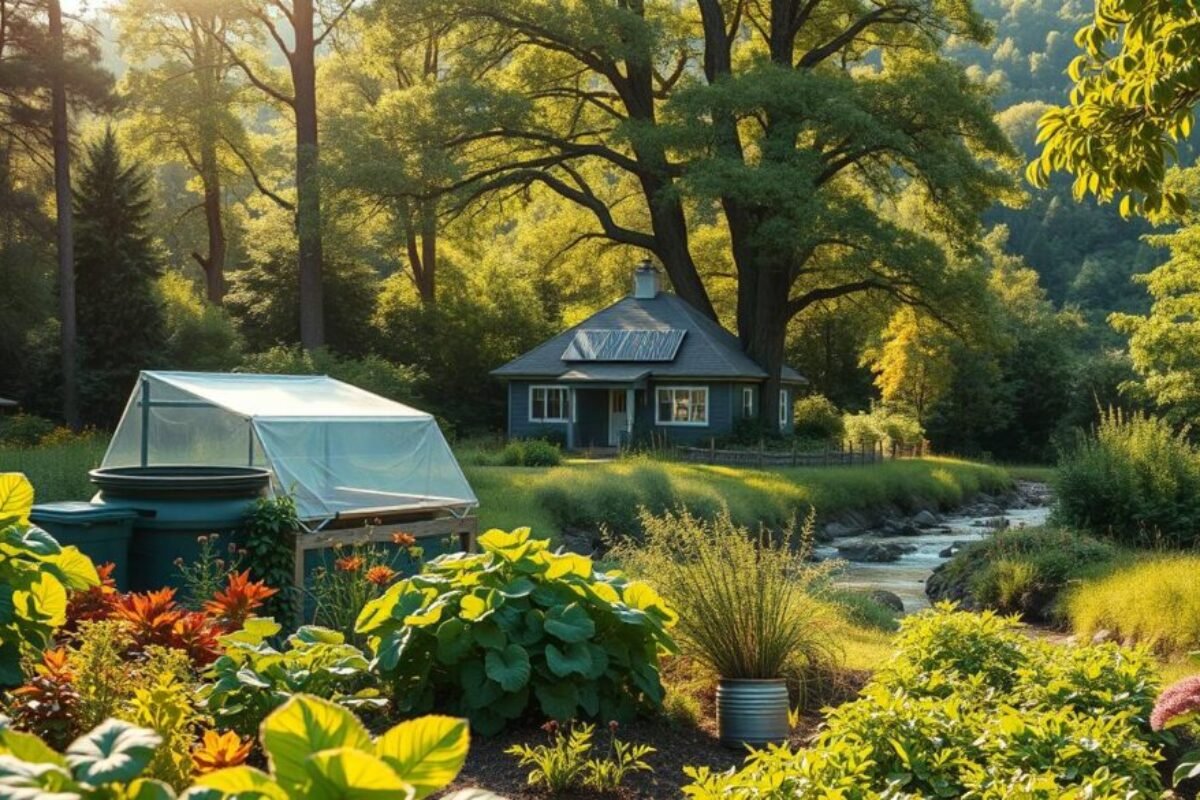Sustainable and Conscious Living: Tips for a Greener Lifestyle
Every American throws away about 4.9 pounds of trash each day. This waste could fill 63,000 garbage trucks, stretching halfway to the moon. It shows how our daily choices harm the planet.
We face big challenges like climate change, air pollution, and water scarcity. We must act now to solve these problems.
Our choices affect Earth’s ecosystems. By living sustainably, we help wildlife and save natural resources. Almost 90% of consumers want businesses to be green and responsible.
Starting an eco-friendly lifestyle means understanding our impact. Our carbon footprint shows how much we use and pollute. By changing our habits, we can protect the planet for the future.
Key Takeaways
- Americans generate 4.9 pounds of trash per person daily, highlighting the urgent need for waste reduction
- 90% of consumers demand more sustainable business practices and eco-friendly products
- Individual actions create meaningful environmental impact when adopted collectively
- Carbon footprint tracking helps measure personal environmental stewardship progress
- Green home practices reduce resource consumption and protect ecosystems
- Daily choices in food, transportation, and consumption directly affect climate change
Understanding Sustainable and Conscious Living in Today’s World
Making climate-conscious choices means knowing what sustainable living is for us every day. Our planet is facing big challenges, and we all have a part to play in making things better. The United Nations set 17 goals for 2030, from fighting climate change to helping the poor and ensuring everyone gets a good education.
What Does Living Sustainably Really Mean?
A sustainable lifestyle definition is more than just recycling or using reusable bags. It’s about making choices that lessen our harm to the environment. This includes how we shop, eat, travel, and work. It’s about picking products made fairly and keeping our carbon footprint low.
The Impact of Our Daily Choices on the Environment
Our daily choices have big effects on the world around us. Mindful consumption helps us see these effects. By picking local food over imported, we cut down on emissions. Choosing durable items over throwaways keeps waste out of landfills. Every time we buy something, we’re either helping or hurting the planet.
Why Individual Actions Matter for Global Change
Ethical consumerism shows that our personal choices add up to big changes. Conservation International says while big changes come from governments and industries, our actions are key. When we all make sustainable choices, we make a real difference. Together, we can change the world by saving energy, reducing waste, and buying responsibly.
Transforming Your Diet for Environmental Stewardship
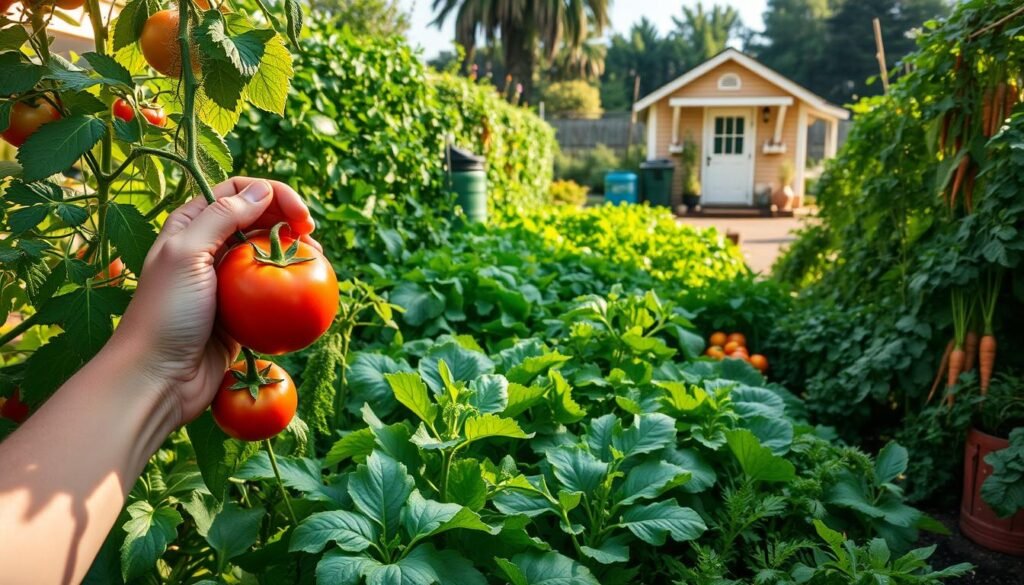
What we eat has a big impact on our planet. Our food choices make up one-third of our carbon footprint. Making small changes in our diet can make a big difference for environmental stewardship.
Reducing Meat Consumption and Its Climate Impact
Livestock production is a big source of greenhouse gas emissions, with cattle being the biggest contributor. A single quarter-pound burger needs 460 gallons of water and releases methane. By choosing plant-based options, we can help the planet.
Embracing Regional and Seasonal Food Choices
Local farmers’ markets offer fresh, locally grown produce. Shopping at these markets reduces emissions. Seasonal eating supports local farmers and connects us with nature.
Fighting Food Waste Through Smart Planning
Almost 40% of edible food in America ends up in landfills. We can fight this by planning our meals and shopping wisely. Making detailed grocery lists and checking pantry inventory before shopping helps. Each meal we save reduces water, energy, and food production resources.
Zero Waste Living and Plastic Reduction Strategies
Every year, we dump at least 14 million tons of plastic into our oceans. This is 80% of all marine debris. It kills thousands of sea creatures that think plastic is food. But, we can change this by living zero waste and making small daily changes.
Our journey to reduce plastic starts with knowing where we waste the most. Americans throw away 23% more trash in December holidays. By picking plastic-free options and sustainable packaging, we can cut down a lot.
| Daily Item | Plastic Version | Zero-Waste Alternative | Annual Savings |
|---|---|---|---|
| Water Container | Disposable bottles | Stainless steel bottle | 156 bottles |
| Coffee Cup | Paper cups with plastic lining | Reusable mug | 260 cups |
| Shopping Bag | Plastic bags | Canvas tote | 365 bags |
| Toothbrush | Plastic brush | Bamboo brush | 4 brushes |
| Soap | Liquid in plastic bottle | Bar soap | 8 bottles |
Switching to zero waste needs smart shopping. Look for unpackaged items at bulk stores and farmers’ markets. Products with the EU Ecolabel are good for the environment. Simple tips include using bar shampoo, toothpaste tablets, and bamboo toothbrushes. Each change helps keep plastic out of our oceans, where 8 million metric tons build up every year.
Creating an Eco-Friendly Home Environment
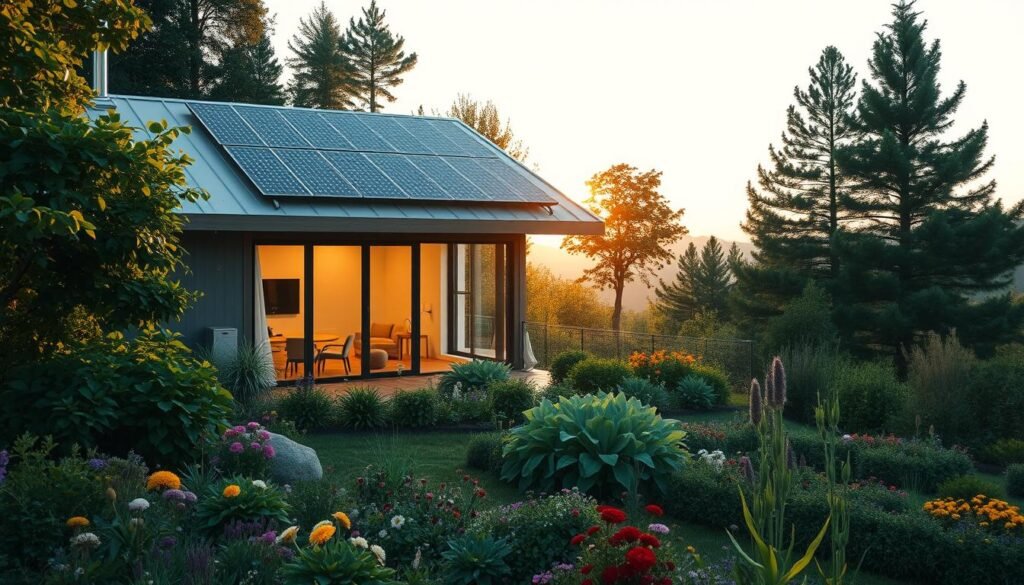
Our homes are key to living green. Making small changes can help the planet and save money. Simple steps like using less energy and natural cleaners can make a big difference.
Energy Conservation Through Smart Appliance Use
Being smart with appliances can cut down on electricity use. Look for second-hand or shared appliances. New ones with ENERGY STAR labels are also a good choice. Turning off computers instead of letting them sleep saves energy too.
These habits can lower your energy bills by 30% each year.
Switching to LED Lighting and Renewable Energy
Incandescent bulbs waste a lot of energy as heat. LED, CFL, or halogen bulbs use much less and last longer. They can cut lighting costs by 80%.
Adding solar panels is a big step towards sustainability. They can cut carbon emissions by 1.6 tons a year, like planting 40 trees.
Proper Heating and Ventilation Techniques
Change HVAC filters every three months to keep things running smoothly. Lowering your thermostat by 7-10 degrees when you’re out saves 10% on heating and cooling costs. Ceiling fans help keep your home cool without needing AC all the time.
Natural Cleaning Products and DIY Alternatives
Commercial cleaners harm our water systems with chemicals. We can use simple, safe ingredients from our kitchens instead. Baking soda, white vinegar, and lemon juice are great for cleaning.
Just a few basic mixes can handle all cleaning tasks. Use vinegar and water for windows or baking soda for tough stains.
Sustainable Fashion and Ethical Clothing Choices

The fashion world has become a huge polluter. Clothing use has grown by 400% in years, with production doubling in two decades. By choosing sustainable fashion and capsule wardrobes, we can make a big difference. Our clothes choices affect the planet, from pollution to water use.
Breaking Free from Fast Fashion
Fast fashion is a big carbon emitter, making up 10% of global emissions. We should change our shopping ways to mindful consumption. Instead of buying new clothes all the time, try thrift stores, swaps with friends, and fixing clothes.
Brands like Patagonia and Eileen Fisher are ethical brands that care about the planet and last long.
Choosing Natural Fibers Over Synthetic Materials
Synthetic fabrics shed microplastics in every wash, harming our oceans. We should pick clothes made from natural fibers like organic cotton, linen, wool, or Tencel. Washing synthetic clothes in cold water and filling the machine helps.
Using washing bags like Guppyfriend can also catch these tiny plastics before they pollute.
Building a Conscious Capsule Wardrobe
Creating a sustainable fashion and capsule wardrobe means picking versatile pieces. We aim for timeless styles, not trends, from ethical brands that last. A good capsule wardrobe has 30-40 pieces that can be mixed and matched.
This approach saves money, reduces stress, and greatly reduces our environmental impact.
Green Transportation and Climate-Conscious Travel
Our daily travel choices have a big impact on the planet. Transportation is a major source of greenhouse gas emissions in the U.S. By making climate-conscious choices about how we travel, we can lessen our environmental footprint.
Walking and biking are the best green transportation options for short trips. They produce no emissions. Public transit is also a great choice. One bus can replace up to 40 cars, helping us all reduce our carbon footprint.
For those who must drive, small changes can make a big difference. We can plan our trips better, keep our tires inflated, and get regular tune-ups. An underinflated tire can increase fuel use by 10%. Car pooling with neighbors or coworkers also cuts emissions and builds community.
| Transportation Mode | CO2 Emissions (grams per km/passenger) | Best Use Case |
|---|---|---|
| Train | 14 | City-to-city travel |
| Bus | 68 | Urban commuting |
| Car | 158 | Rural areas |
| Airplane | 285 | Long-distance only |
Sustainable travel means smart choices for long trips. Direct flights are better than connecting ones because they have fewer takeoffs and landings. And remember, packing light helps reduce fuel use for all passengers.
Water Conservation and Mindful Consumption Practices
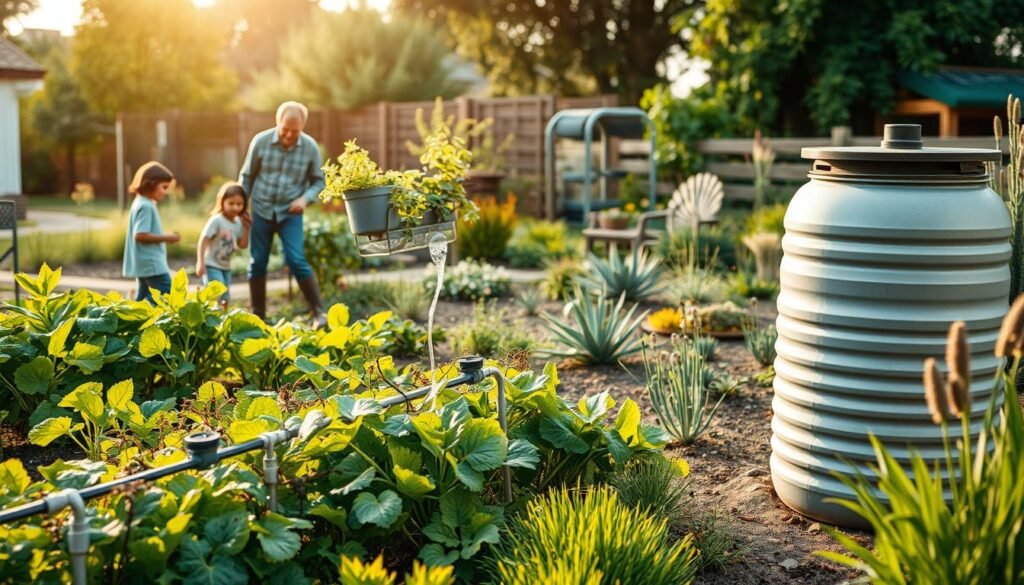
Every drop counts when it comes to sustainable water use in our homes. Droughts are becoming more common in the United States. We must change how we use this precious resource. Small changes in our daily lives can save a lot of water and money.
Simple Water-Saving Techniques at Home
We can start saving water with simple steps. Installing low-flow showerheads and faucet aerators can cut water use by up to 50%. Fixing a leaky toilet saves about 200 gallons of water every day. Turning off the tap while brushing teeth or washing dishes saves 8 gallons per minute.
Using cold water for laundry saves energy. About 90% of a washing machine’s energy is for heating water. This change saves around $40 a year and makes clothes last longer.
Understanding Water Footprints in Food Production
Our food choices affect mindful consumption of water. It takes 1,800 gallons of water to produce one pound of beef. Vegetables need only 39 gallons per pound. Eating less meat one day a week saves enough water for 52 bathtubs a year.
Drought-Resistant Landscaping and Xeriscaping
Creating beautiful yards with drought-resistant landscaping saves water. Native plants like Black-Eyed Susans and Purple Coneflowers need little water. These gardens attract butterflies and bees, saving time and money on water bills by up to 60%.
Ethical Consumerism and Supporting Sustainable Brands
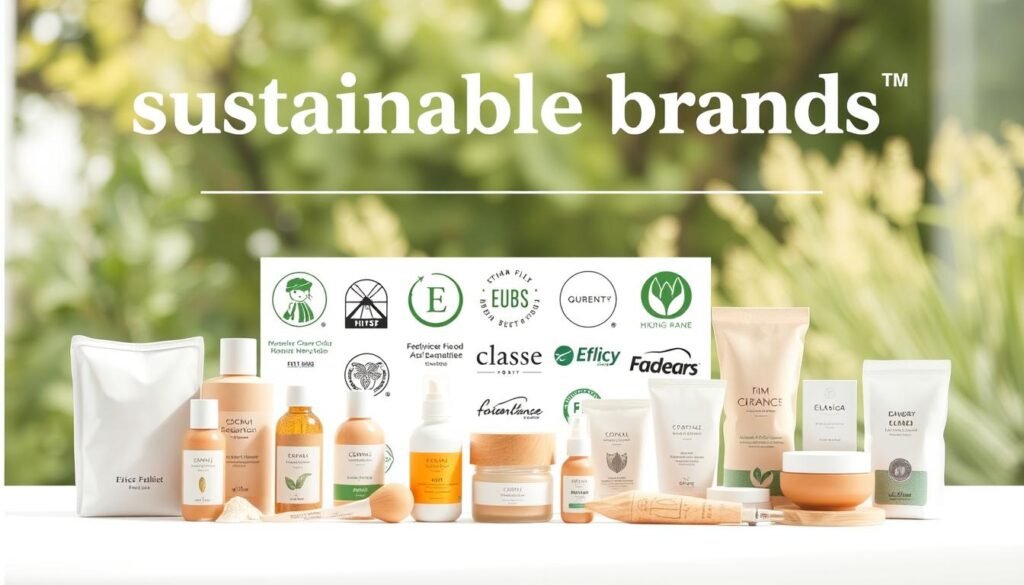
Every time we buy something, we help shape the world. Choosing products wisely means we’re voting for the future we desire. Ethical consumerism involves thinking about an item’s journey – from raw materials to packaging waste.
Before we shop, let’s ask ourselves: do we really need this? Sometimes, the best choice is to buy nothing. Secondhand stores and online marketplaces offer great alternatives. Sites like ThredUp and Poshmark make finding pre-owned items easy.
Reading reviews helps us make better choices. We look for companies that focus on:
- Fair trade certifications for coffee, chocolate, and tea
- Organic materials that reduce chemical pollution
- Minimal or biodegradable packaging
- Transparent supply chains
- Products with EPA Safer Choice or USDA Organic labels
Some brands have earned our trust. Patagonia fixes clothes instead of replacing them. Dr. Bronner’s uses organic ingredients and fair trade. Seventh Generation makes cleaning products without harmful chemicals. These companies show that success and caring for the planet can go together.
We make choices with our money every day. By supporting values-driven businesses and avoiding harmful ones, we encourage better practices. This way, we help create a better world for all.
Urban Gardening and Composting Solutions
Growing our own food and managing organic waste at home has a big impact. We can turn small spaces into gardens and kitchen scraps into soil. These actions help the environment and support local food systems.
Starting Your Own Food Garden in Small Spaces
Urban gardening turns windowsills, balconies, and small yards into gardens. We can grow herbs like basil and mint in mason jars. Lettuce and tomatoes do well in window boxes.
Vertical gardens make the most of small spaces. We can use wall planters or hanging baskets for strawberries and beans. A 4×4 foot bed can grow enough veggies for summer salads.
Setting Up an Effective Composting System
Composting turns food waste into fertilizer. It prevents methane and saves money. Indoor options include worm bins and countertop containers. Outdoor systems range from simple piles to tumblers.
| Composting Method | Space Needed | Time to Compost | Best For |
|---|---|---|---|
| Worm Bin | 2×2 feet | 2-3 months | Apartments |
| Tumbler | 3×3 feet | 6-8 weeks | Small yards |
| Three-Bin System | 9×3 feet | 3-4 months | Large gardens |
Community Supported Agriculture Programs
Community Supported Agriculture connects us with local farms. We get weekly boxes of fresh produce. Farms like Angelic Organics in Illinois offer unique varieties.
Many CSA farms have work-share options. We can trade labor for discounts on produce. This supports local farmers and reduces food miles.
Minimalism and the Buy Nothing Movement
We’re often told we need more stuff to be happy. But what if less is more? The minimalism and Buy Nothing Movements are changing how we see our belongings and their effect on Earth.
Questioning Consumption Before Purchase
Before buying, we should ask ourselves hard questions. Do we really need that new monitor? Will that fifth pair of jeans make us happier? The Buy Nothing Movement teaches us to think twice about buying. Every item we skip means less trash and fewer resources used.
Sharing Economy and Community Resources
The sharing economy is making our neighborhoods more sustainable. We don’t all need to own everything. Apps and local groups let us borrow tools and share costs. Car-sharing services cut down on the need for personal cars in cities.
This approach saves money and strengthens community bonds.
Repair Cafés and Extending Product Life
Repair cafés are appearing everywhere, from Portland to Brooklyn. They offer free help fixing broken items. Keeping our phones for three to four years instead of upgrading saves a lot of energy.
The energy to make one phone is like charging it for ten years. Choosing refurbished items and fixing what we have is key to living sustainably.
Digital Sustainability and Reducing Electronic Waste
Our digital habits have a hidden environmental impact. Every device, email, and video stream uses energy and creates waste. By using eco-friendly tech, we can lessen our digital footprint.
Devices use energy even when not in use. This “phantom power” is a big part of our bills. Unplugging and using power strips can save energy and money.
Emails also have a big environmental cost. The networks that handle our emails use a lot of energy. A year of emails is like driving 200 miles in carbon emissions. We can help by:
- Deleting old messages regularly
- Unsubscribing from unwanted newsletters
- Turning off unnecessary social media notifications
- Using cloud storage efficiently
Streaming also affects the environment. Different devices use different amounts of energy for the same content:
| Device Type | Energy Usage (per hour) | Carbon Impact |
|---|---|---|
| Smart TV | 100-150 watts | Highest |
| Laptop | 30-50 watts | Medium |
| Smartphone | 5-10 watts | Lowest |
Choosing sustainable electronics and keeping them longer helps. We can watch content offline, use energy-saving modes, and fix gadgets instead of buying new ones.
Teaching Children About Environmental Responsibility
We can shape our children’s future by teaching them about environmental responsibility early. Kids learn best through hands-on experiences that make sustainability fun. When we make green practices part of our daily lives, kids develop habits that help our planet.
Age-Appropriate Sustainability Activities
Young children learn through play and exploration. We can start with simple activities like recycling sorting games and nature scavenger hunts. Preschoolers can make bird feeders from pinecones and peanut butter.
Elementary students can track their family’s energy usage on colorful charts. Middle schoolers can learn about the UN’s 17 Sustainability Goals through interactive projects and community service.
Creating Eco-Friendly School Supplies and Lunches
We can make school routines more sustainable. Replace disposable items with reusable ones like stainless steel lunch boxes and cloth napkins. Choose eco-friendly school supplies like recycled paper notebooks and refillable pens.
Use natural materials for craft projects instead of harmful ones. Dried leaves, recycled construction paper, and wooden craft sticks are great alternatives.
Family Projects for Greener Living
Our family sustainability projects create lasting memories and protect Earth. Start a vegetable garden where kids can plant seeds and harvest produce. Build a backyard composting bin together to turn food scraps into soil.
Create an indoor pollution-fighting garden with spider plants and peace lilies. These shared experiences show how small actions can make a big difference in our world through green education.
Measuring Your Environmental Impact
Understanding our personal effect on the planet starts with concrete data. We can use various tools for environmental impact measurement to see where we stand. This knowledge empowers us to make informed decisions about our daily habits.
Calculating Your Carbon Footprint
A carbon footprint calculator is a great tool for understanding personal emissions. Conservation International offers free online tools to analyze emissions from different areas of our lives. Diet, transportation, home energy, and shopping habits are all considered.
Setting Achievable Sustainability Goals
After measuring our environmental impact, we can set realistic targets. Start with specific, manageable changes:
- Reduce meat consumption by one day each week
- Switch to renewable energy providers
- Bike to work once weekly to cut emissions by 20%
- Monitor monthly water and energy usage
These goals align with the United Nations’ 17 global objectives. Countries like Germany have committed to these goals.
Tracking Progress and Celebrating Small Wins
Tracking progress keeps us motivated. Record monthly data for water usage, waste production, and energy consumption. Every reduction counts, big or small.
Share successes with friends and family to inspire their own changes. Being a role model matters, even when we face challenges.
Conclusion
Our journey to a greener lifestyle begins with daily choices. Eating less meat and choosing local produce can greatly reduce our carbon footprint. By adopting zero-waste habits and avoiding single-use plastics, we help our oceans and wildlife.
These small steps, when combined with bigger changes in industries and governments, lead to significant environmental benefits. It’s all about taking action for our planet.
We don’t have to be flawless to make a difference. Begin with something simple, like using LED bulbs or shopping at farmers markets. Visit repair cafés to fix items instead of buying new ones.
Support companies that care about the environment, like Patagonia and Eileen Fisher. Use online tools from the EPA to track your progress and set achievable goals for a greener lifestyle.
Building a sustainable future requires everyone’s effort. Share your eco-friendly tips with others. Teach kids about composting and saving energy through fun activities.
Join Buy Nothing groups on Facebook to exchange resources in your community. Surveys in Germany show 90% of people want sustainable businesses. Every choice we make impacts our environment.
By living consciously and preserving nature, we create a healthier world for future generations. Let’s work together to make it happen.
